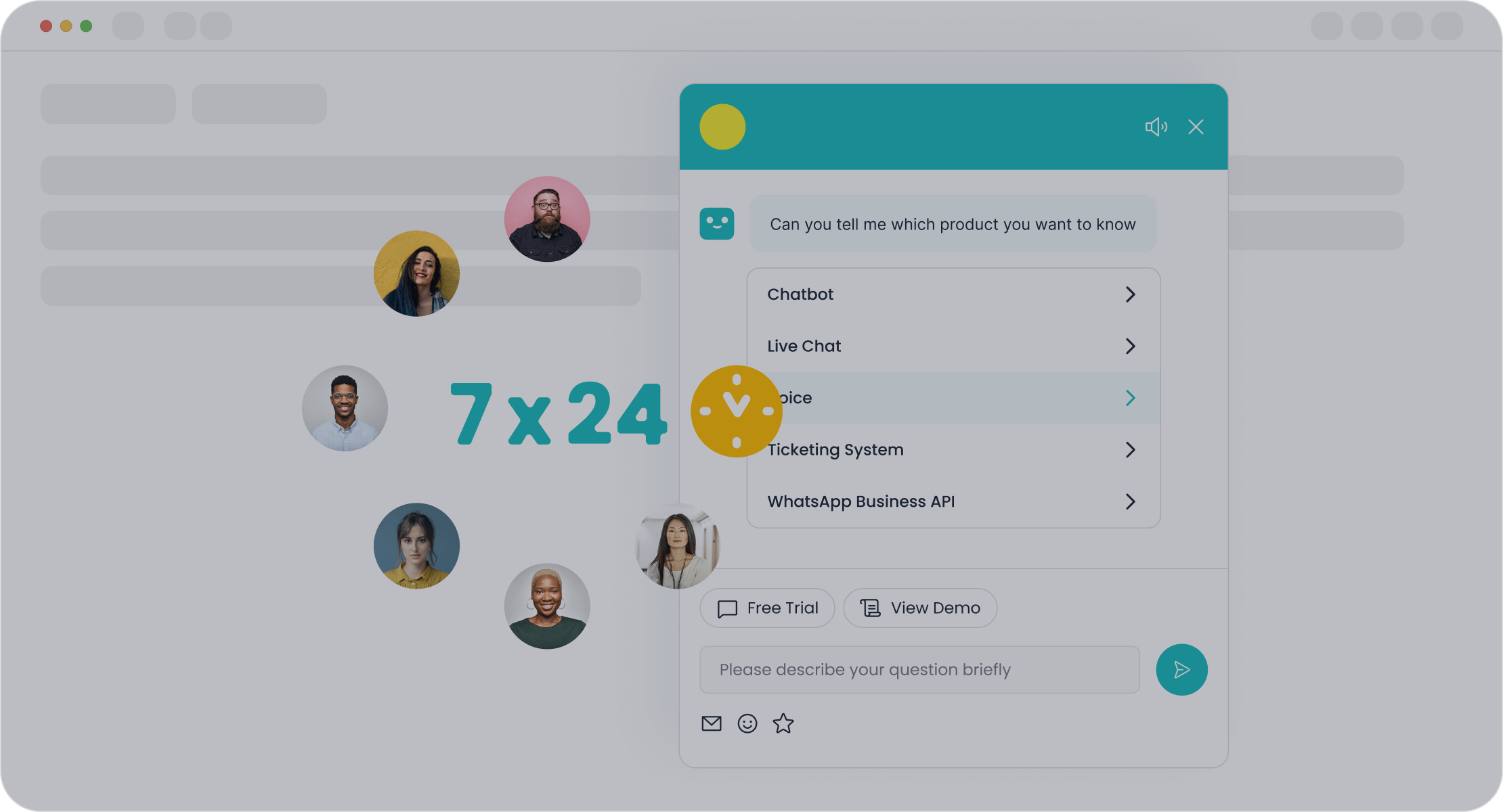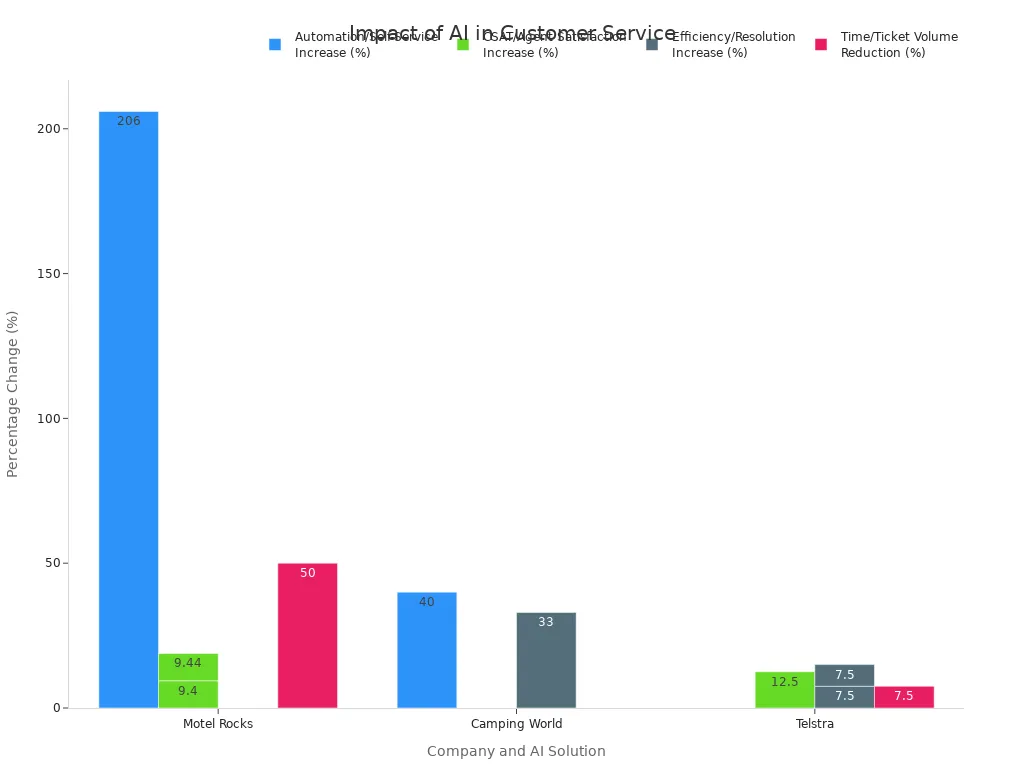Using AI for Customer Engagement in 2025

In 2025, your customers will expect instant and personalized service, anticipating that any employee they interact with will have full context of their situation. This demand for superior engagement is reshaping business, making effective AI strategies crucial. This guide offers actionable AI plans for boosting customer engagement, highlighting why AI is no longer optional but essential for a competitive customer experience. As companies rapidly adopt AI, with about 80% planning to use AI chatbots by 2025, finding the best AI software for customer engagement across channels 2025 is paramount. Sobot AI stands out as a leading solution, offering comprehensive tools that integrate seamlessly into your operations. With Sobot, businesses can leverage advanced AI to meet these high expectations, transforming their customer interactions. The Sobot call center solutions, for instance, are designed to enhance efficiency and personalization, ensuring your business stays ahead in the evolving customer service landscape.
Core AI Powered CX Strategies for Better Customer Engagement
An exceptional customer experience is no longer a luxury; it is the new standard. In 2025, your success depends on your ability to deliver proactive, personalized, and instant service. This requires moving beyond traditional methods and embracing a new set of tools. Adopting core AI powered CX strategies is the key to unlocking deeper customer engagement and building lasting loyalty. These strategies empower you to understand your customer on a new level, anticipate their needs, and provide support exactly when they need it.
By leveraging AI, you can transform raw data into actionable insights, creating a seamless and intelligent customer journey. The AI in customer experience (CX) market is a testament to this shift, with significant growth projected in the coming years.
| Metrics | Value |
|---|---|
| Industry Size (2025E) | USD 12.95 billion |
| Industry Value (2035F) | USD 51.5 billion |
| CAGR (2025 to 2035) | 14.8% |
This growth is fueled by the clear advantages that AI powered CX strategies bring to businesses. Let's explore four fundamental strategies that will define customer engagement in 2025.
Anticipate Needs with Predictive Analytics
Imagine knowing what your customer wants before they do. Predictive analytics makes this possible. This AI powered CX strategy uses historical and real-time data to forecast future behaviors, trends, and outcomes. Instead of reacting to customer needs, you can proactively address them, creating a powerful and personalized experience.
Predictive analytics works by analyzing various data sources:
- Transaction Data: This includes purchase history, frequency, and spending habits.
- Behavioral Data: This tracks how customers interact with your website, app, or marketing materials.
- Feedback Data: This gathers insights from surveys, reviews, and support interactions.
By processing this information, AI models can identify patterns and predict actions, such as which customers are likely to churn or what products they might buy next. For example, Slack uses predictive analytics to identify at-risk accounts by analyzing user engagement patterns, which helped them achieve a 30% decrease in churn. Similarly, The Willow Tree Boutique used predictive analytics to promote luxury items to high-value customers, resulting in a 53.1% revenue growth in just six months. These examples show how data-driven insights can lead to powerful customer engagement strategies.
Deliver 24/7 Support with AI Chatbots
In today's digital world, customers expect answers instantly, at any time of day. AI chatbots are the perfect solution for meeting this demand. They provide 24/7 support, handle routine queries, and free up your human agents to focus on more complex issues. This not only improves efficiency but also significantly cuts operational costs. Studies show that AI interactions can be up to 12 times more cost-effective than human ones, with some companies seeing profit improvements of up to US$40 million by using AI chatbots to perform the work of hundreds of agents.

A prime example of a powerful chatbot solution is the Sobot AI Chatbot. It offers several key features that make it an invaluable tool for modern businesses:
- 24/7 Availability: Your customers get instant support around the clock, enhancing customer satisfaction.
- Multilingual Support: The chatbot can communicate with your global customer base in their preferred language, breaking down communication barriers.
- No-Code Setup: You can design and deploy automated workflows with a simple point-and-click interface, no coding required.
- Proven ROI: Sobot's AI chatbots are proven to cut service costs by up to 50% and boost conversions by 20% through smart self-service and proactive messaging.
By implementing advanced AI chatbots, you create a responsive and efficient support system that enhances the customer experience and drives business growth.
Drive Deeper Connections with Personalization
Generic marketing messages no longer work. Customers crave personalization; they want to feel seen and understood. AI-driven personalization allows you to tailor every interaction to the individual customer, from product recommendations to marketing communications. This strategy uses AI to analyze customer data in real-time, delivering relevant content at the perfect moment.
The impact of personalization is undeniable. McKinsey reports that personalization can drive up to a 15% revenue uplift for e-commerce businesses. Furthermore, 80% of consumers are more likely to buy from a company that offers personalized experiences.
Tip: Use AI to create dynamic customer profiles that update in real-time. This allows for precise and relevant communication, unlike static loyalty programs.
Sobot's AI solution for retail demonstrates how effective this can be. By analyzing customer behavior, the AI can:
- Deliver Real-Time Product Recommendations: Just like Amazon, which generates over 35% of its revenue from its recommendation engine, you can suggest products based on a customer's browsing history and past purchases.
- Optimize Promotional Campaigns: AI helps reduce cart abandonment by delivering targeted promotions and creating custom product bundles.
- Automate Outbound Marketing: Use AI to conduct automated marketing campaigns that can improve sales by over 30%.
This level of real-time personalization fosters a deeper connection with your customer, boosting loyalty and increasing lifetime value. It is a cornerstone of modern AI marketing strategies.
Understand Emotion with Sentiment Analysis
Effective communication is about more than just words; it's about understanding the emotion behind them. Sentiment analysis is an AI powered CX strategy that analyzes text and speech to determine the emotional tone of a customer's interaction. This technology helps you gauge customer feelings—whether they are happy, frustrated, or confused—and respond appropriately.
By using sentiment analysis, you can:
- Identify At-Risk Customers: The AI can flag negative sentiment in support tickets, chats, or calls, allowing you to intervene proactively before a customer churns. For instance, after implementing sentiment tools, the travel company James Villas reduced its resolution times by 51% by automatically flagging urgent calls.
- Improve Products and Services: Analyzing customer feedback provides valuable insights into what your audience loves and what needs improvement.
- Enhance Agent Training: Data from sentiment analysis can be used to train your support team on how to handle difficult conversations and improve overall customer satisfaction.
Happy customers are loyal customers. They spend up to 140% more and are 1.5 times more likely to remain loyal to a brand that provides tailored experiences. Integrating sentiment analysis into your AI powered CX strategies gives you the customer insights needed to build stronger relationships and drive long-term success.
A Practical Framework for AI Implementation
Adopting AI is more than just buying software; it requires a thoughtful plan. A practical framework ensures your AI strategies align with your business objectives and deliver real value. This structured approach helps you navigate complexities, manage resources, and measure success effectively. Follow these four steps to build a strong foundation for your AI-powered customer engagement initiatives.
Define Your Engagement Goals
Before you implement any AI tool, you must first define what you want to achieve. Clear goals will guide your strategy and help you measure your return on investment. What does success look like for your business? Your objectives for customer engagement will shape which AI solutions you choose and how you use them.
Common goals for businesses using AI include:
- Providing 24/7 Availability: Do you want to offer instant support around the clock?
- Reducing Customer Effort: Is your aim to make it easier for customers to find answers and solve problems?
- Improving Team Efficiency: Are you looking to automate repetitive tasks to free up your agents?
- Gaining Deeper Insights: Do you need to better understand customer behavior and sentiment?
- Lowering Operational Costs: Is your primary goal to reduce spending on customer service?
Setting clear targets for your AI implementation is the first step toward transforming your customer experience and achieving meaningful business growth.
Prepare Your Data and Integrate Systems
AI is powered by data. The quality of your data directly impacts the performance of your AI models. To get reliable results, you need clean, organized, and accessible data. This preparation phase is critical for a successful AI deployment. You should start by creating a data governance strategy that defines how you collect, store, and manage customer information.
Follow these best practices to prepare your data:
- Identify Data Sources: Locate all systems that contain customer data, such as your CRM, e-commerce platform, and support tools.
- Standardize Formats: Define consistent formats for information like dates, names, and currencies across all your data sources.
- Clean Your Data: Implement processes to remove duplicate entries, fix errors, and fill in missing values. Accurate data leads to accurate AI predictions.
- Invest in a Central Hub: Consider a customer data platform to unify information from different sources, giving your AI a complete view of each customer.
Integrating AI with existing systems can present challenges. Many platforms were not designed for AI and may struggle with data quality issues or legacy components. This makes careful planning and a focus on data integrity essential for a smooth integration.
Proper data preparation ensures your AI has the high-quality information it needs to enhance customer engagement and deliver powerful insights.
Start Small with a Pilot Project
Jumping into a full-scale AI deployment can be overwhelming. A better approach is to start with a pilot project. A small, focused project allows you to test your AI strategies, measure initial results, and gather valuable feedback with lower risk. You can identify a specific pain point, like high call volume for a common issue, and use AI to address it.
A successful pilot project builds momentum and demonstrates the value of AI to your organization. Many companies have seen remarkable results from starting small.
| Company | AI Solution Type | Impact & Results |
|---|---|---|
| Amtrak | AI Virtual Assistant | Handled over 5 million customer requests annually, increasing self-service bookings by 25%. |
| Bank of America | Conversational AI | Manages over 2 million customer interactions daily, answering 98% of routine questions in under 44 seconds. |
| Motel Rocks | AI Chatbot | Automated 43% of incoming tickets and increased customer satisfaction (CSAT) by over 9%. |
These examples show that even focused AI projects can deliver significant improvements in efficiency and customer satisfaction.

Once your pilot proves successful, you can use the lessons learned to scale your AI implementation across other areas of the business.
Empower Your Team for AI Collaboration
AI is not here to replace your team; it is here to empower them. For a successful implementation, you must prepare your employees to work alongside AI. This involves training them on new tools and workflows. Your team needs to understand how AI can help them become more efficient and effective in their roles.
A structured training program is key.
- Assess Current Skills: Evaluate your team's technical abilities to identify any knowledge gaps.
- Design Targeted Training: Create learning modules based on real-world scenarios your team faces every day.
- Implement Hands-On Practice: Start with basic AI features and gradually introduce more advanced tools as your team builds confidence.
For AI and human agents to collaborate effectively, your team must learn new skills. They need to know when to trust an AI suggestion, how to personalize an automated response, and when to take over a conversation to provide a human touch.
By investing in training, you turn your team into confident users of AI. This collaboration between human expertise and AI efficiency is what creates a truly exceptional customer experience and drives powerful engagement.
Choosing the Best AI Software for Customer Engagement Across Channels 2025
Selecting the right AI platform is a critical step in your customer engagement strategies. The market offers many options, but the best AI software for customer engagement across channels 2025 will unify your communications and protect your customer data. You need a solution that empowers your team, not complicates their workflow. Evaluating platforms on a few key criteria ensures you find a partner for long-term success. This decision will define your ability to deliver seamless customer experiences. Finding the best AI software for customer engagement across channels 2025 is essential for your business growth.
Evaluating Omnichannel Capabilities
Your customers connect with you through many channels. A truly effective AI solution brings them all together. You should look for a platform that unifies interactions from WhatsApp, chat, voice, and social media into a single interface. This creates a continuous conversation. Your customer never has to repeat their story, and your agents have the full context to provide better support. This unified approach is a hallmark of the best AI software for customer engagement across channels 2025. It boosts customer satisfaction and makes your team more efficient. Strong omnichannel AI is fundamental to modern customer engagement.
Prioritizing Data Security and Compliance
Customer trust is your most valuable asset. Protecting customer data is not optional. When choosing an AI platform, you must prioritize security. The best AI software for customer engagement across channels 2025 will offer robust data protection features.
For example, a platform should be fully compliant with regulations like GDPR. Look for features like data encryption and secure data backups. This ensures your customer information is always safe. Strong security shows your commitment to your customer and protects your business from risk. This is a non-negotiable part of your AI strategies.
Assessing Ease of Use and Implementation
The most powerful AI tool is useless if your team cannot use it. The best AI software for customer engagement across channels 2025 should be intuitive and easy to implement. Look for solutions with no-code interfaces, like Sobot’s point-and-click chatbot builder. This allows your team to design and deploy AI workflows without needing technical expertise. A smooth implementation process means you can start improving customer engagement faster. The right AI partner provides training and support to ensure your team feels confident.
Analyzing Reporting and Analytics Features
You need to measure the impact of your AI strategies. A great AI platform provides powerful reporting and analytics tools. These features help you track key metrics and understand the performance of your AI. You can monitor chatbot resolution rates, customer satisfaction scores, and agent productivity. This data gives you the insights needed to optimize your engagement efforts. Clear reporting demonstrates the ROI of your AI investment and helps you make informed decisions to improve the customer journey.
Measuring the ROI of Your AI Engagement Strategy

Investing in AI requires you to prove its value. Measuring the return on investment (ROI) of your AI engagement strategies shows you what works and justifies further spending. You can see tangible results, just like OPPO did with Sobot. They achieved an 83% chatbot resolution rate, a 94% positive feedback rate, and a 57% increase in repurchase rate. This success demonstrates the powerful impact of a well-measured AI plan. To see similar returns, you must focus on the right data.
Tracking Key Service Metrics
You should first track key service metrics to see how AI improves your support quality. These numbers give you a clear picture of your AI's performance. They show how efficiently your AI is solving customer problems without human help. Good data here points to lower costs and happier customers.
| Metric | What It Shows |
|---|---|
| Automated Resolution Rate (ARR) | The percentage of issues your AI solves alone. |
| Customer Satisfaction (CSAT) | How happy customers are with the AI interaction. |
| Average Handling Time (AHT) | The average time AI takes to resolve an issue. |
Tracking this data helps you understand the direct impact of AI on your service operations and customer satisfaction.
Analyzing Customer Engagement Rates
Your AI strategies should boost customer engagement. You need to analyze data from every channel to get a full picture. Look at how customers interact with your website, emails, and social media. High engagement means your content is relevant and your AI personalization is working.
Key engagement metrics to watch include:
- Click-through rate (CTR): Shows if your AI-powered calls-to-action are effective.
- Average session duration: Tells you if your content keeps the customer's attention.
- Bounce rate: Indicates if visitors leave your site too quickly.
This data helps you refine your AI strategies for better customer connections.
Calculating Agent Productivity Gains
AI makes your team more productive. To measure this, you need to compare performance before and after implementing AI. Establish a baseline by looking at your team's data for the last few months. After you launch your AI tools, track the changes. You will likely see that AI handles repetitive questions, freeing your agents for more complex work. This collaboration between your team and AI is a huge productivity win. It allows your agents to provide higher-value support, which directly improves the customer experience.
The Future of AI in Customer Service

The future of customer service is intelligent, proactive, and deeply connected. As you look toward 2025, AI will not just be a tool but the central nervous system of your customer experience. These evolving AI strategies will redefine how you build relationships and drive loyalty. Understanding these trends helps you prepare for the next wave of customer engagement.
The Rise of Generative AI in Service
Generative AI is transforming customer service from reactive to creative. This technology creates new, human-like content for every interaction. By 2025, AI is expected to handle 95% of all customer interactions, making personalization the new standard. Companies like Spotify and Samsung already use generative AI to deliver tailored recommendations and playlists. This level of personalization creates better customer experiences. Investing in these AI marketing strategies can deliver a significant return, with some companies seeing up to an 8x ROI. The AI helps your team work faster and smarter, boosting productivity and satisfaction.
Integrating AI Across the Customer Journey
Your customer journey is a series of touchpoints. AI connects them all seamlessly. You can use AI to predict customer needs before they arise. For example, AI models can identify customers at risk of churning and trigger proactive outreach. This creates a smoother experience for every customer. AI also empowers your support teams with agent-assist tools that suggest replies and summarize tickets. This integration of AI across the entire journey ensures a consistent and intelligent experience, from initial marketing to post-sale support. These strategies help you build stronger relationships.
Balancing Automation with the Human Touch
Automation is powerful, but it cannot replace human connection. The best approach blends AI efficiency with human empathy. You should use AI for repetitive tasks, which frees your team to handle complex and emotional issues.
A blended AI approach where automation can help the human be more human is most ideal. Having artificial intelligence focus on the repetitive tasks allows the employee to concentrate on human-based skills. — Graeme Provan, Global Director of Business Automation at Genesys
Even with advanced AI, 75% of consumers still prefer talking to a person for difficult problems. A successful strategy ensures a smooth handoff from an AI chatbot to a human agent when needed. This balance is key to great customer engagement.
To create the proactive customer experiences your customer expects in 2025, you must adopt AI. The future of customer engagement is predictive, and AI is essential for this shift. Key AI strategies like predictive analytics and chatbots, guided by a clear plan, help you anticipate customer needs. The right AI partner helps you blend powerful technology with a human touch. This balance builds strong customer loyalty. Let Sobot guide you as you Embark on Your Contact Journey.
FAQ
How does AI improve the customer experience?
You can use AI to provide instant, 24/7 support for every customer. It personalizes interactions and anticipates customer needs. This creates a smoother journey and builds stronger customer relationships, leading to higher satisfaction.
What is the first step to implementing AI for customer service?
You should first define your engagement goals. Decide what you want to achieve. Do you want to lower costs or improve customer satisfaction? Clear goals guide your strategy and help you choose the right tools for your customer.
Can AI completely replace my human customer support team?
No, AI empowers your team, it does not replace it. AI handles simple, repetitive tasks. This frees your human agents to focus on complex problems where empathy and a human touch are essential for the customer.
How do I choose the right AI software for my business?
You should look for a platform with strong omnichannel features to unify every customer conversation. Prioritize data security to protect customer information. Also, choose a solution that is easy for your team to use and provides clear analytics.
See Also
Optimizing Customer Support: AI Software Drives Unprecedented Efficiency Gains
Essential AI Solutions: Ten Powerful Tools for Enterprise Contact Centers
In-Depth Analysis: Evaluating Leading AI Solutions for Enterprise Call Centers
Comprehensive Handbook: Navigating Artificial Intelligence Software for Call Centers
Transforming Customer Interactions: AI Agents Revolutionize Service and Support
